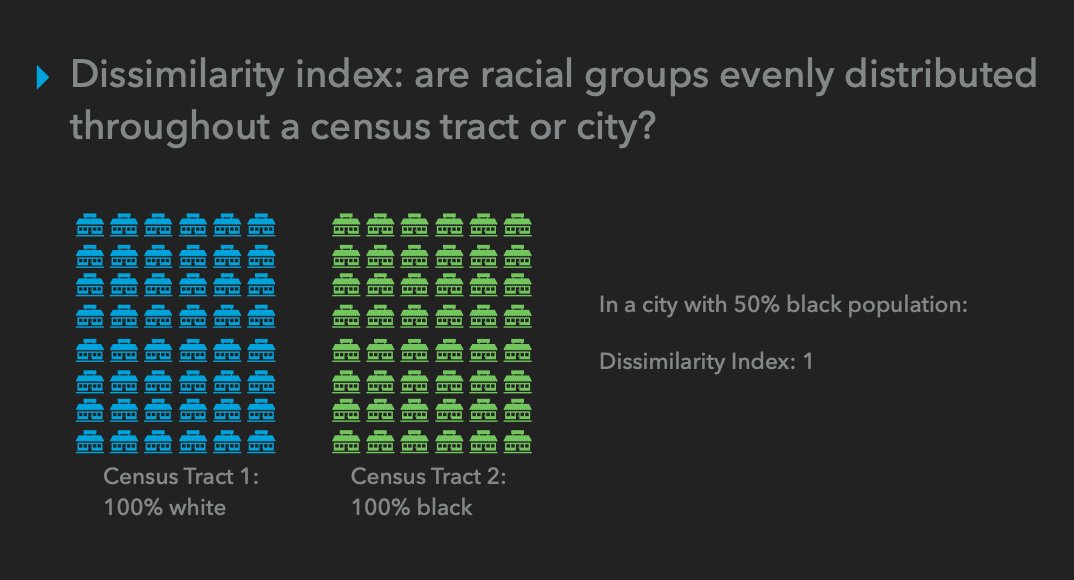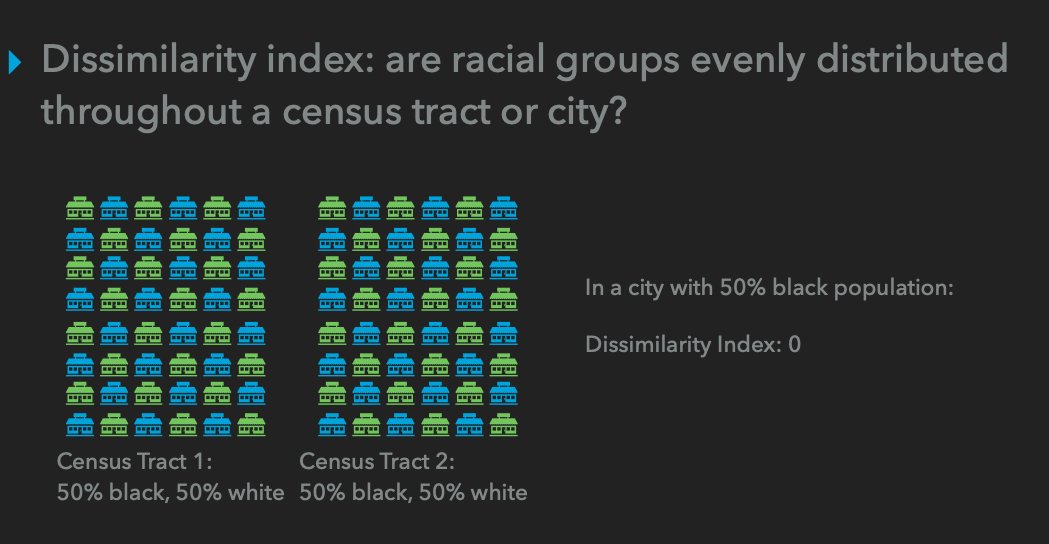Thread on the idea for one of the most significant papers I& #39;ve read in the last 5 years. and it comes from *lived experience* https://twitter.com/TrevonDLogan/status/1198982297585766402">https://twitter.com/TrevonDLo...
If you haven& #39;t read Trevon Logan and John Parman& #39;s paper, "The National Rise in Residential Segregation," please do https://www.cambridge.org/core/journals/journal-of-economic-history/article/national-rise-in-residential-segregation/C6CDA8CE8E2A0F2523EAE4C7BACB8E2A">https://www.cambridge.org/core/jour...
I want to explain why this paper and its origin matter so much. As a young race scholar in sociology, when we& #39;d study segregation, THE book was Massey and Denton& #39;s American Apartheid, and THE measure to use came from their work. https://www.hup.harvard.edu/catalog.php?isbn=9780674018211">https://www.hup.harvard.edu/catalog.p...
the "dissimilarity index" was M&D& #39;s main measure used. it captures how many people would have to move for races to be evenly distributed by census tract. hang on, I have slides bc I started teaching this for research methods, my poor (lucky) students
some advantages of this measure: you have the data, you can compare over time and place, you can study segregation where people think of it happening: in cities. And you do want to know if census tracts are divided as above, or "integrated" like this ex w/dissimilarity index of 0
However: neighborhoods =/=census tracts, this isn& #39;t necessarily how people experience segregation, and the DI isn& #39;t nec going to capture all forms of segregation. For instance, this spatial layout w/in a census tract has a DI of 0, just like the last example.
The limitations of this method were well known ten years ago when I started reading on this, but it was less of a "let& #39;s improve this" attitude and more of a "well, it& #39;s the best we& #39;ve got so let& #39;s keep going with it."
The people using it were able to do what they wanted to do, which is generally show that segregation, incl "hypersegregation," was still present in US cities, and then tie it to disparate outcomes. they wanted to measure it, they could measure it. good enough
I applied to soc PhDs with a research statement about wanting to figure out new measures for segregation. I wasn& #39;t sure what that looked like yet. I just knew there was something better.
in this time, my colleague at Duke, @SarahMayorga, wrote a great ethnography of a nominally "integrated" neighborhood/census tract, which shows the limits of the DI measurement in capturing the very segregated lives she observed https://uncpress.org/book/9781469618630/behind-the-white-picket-fence/">https://uncpress.org/book/9781...
Then comes Logan and Parman& #39;s paper. They used a completely different measure: whether the houses on both sides of you were inhabited by ppl of the same race.
this measure relates better to lived exp of segregation. you prob don& #39;t know your census tract boundaries but you definitely know who lives on either side of you. It also has a simplicity that scales up well: it& #39;s algorithmic. like binary erosion https://www.cs.auckland.ac.nz/courses/compsci773s1c/lectures/ImageProcessing-html/topic4.htm">https://www.cs.auckland.ac.nz/courses/c...
It also captures different forms segregation can take in different regions/cities/racial regimes. It& #39;s not imposing a single model of what segregation looks like, it& #39;s more inductive to allow you to see different arrangements. which is what we need
AND, huge, it& #39;s a single measure that can be used in rural areas and urban areas. People were making all kinds of assumptions about rural areas and the South in general without actually having a measure that worked outside cities.
@TrevonDLogan explains he got this idea from his grandma describing her nbrhood house by house. brilliant. listen to people and how they understand their world.
@Soon2bDrElamin& #39;s diss on Knoxville, which I can& #39;t wait to be published as a book, and @mindphul& #39;s work on urban renewal have similar attn to spatial narratives and recovering lost geographies through interviews https://nyupress.org/9781613320198/root-shock/">https://nyupress.org/978161332...
Oh. AND it& #39;s exploiting century-old metadata! Which is a big part of why I taught it for methods. the files were in order of how you& #39;d walk door to door to admin the census, so you could reconstruct the neighborhood through the order of files.
and THEN, on top of all that, they didn& #39;t just intro the measure but used it to measure segregation, nationally, for all counties, 1880-1940 (far before the usual start date). and what they found explodes a lot of our assumptions about US history.
but guess what, read the paper to find out! This thread is about the methodology. hearing that it was dismissed as not novel or important doesn& #39;t surprise me, but it& #39;s an abominable ex of path dependency in our fields. and lack of caring about non-cities or the South.
and the paper is just good: the measure makes intuitive sense. most of the analysis uses descriptive stats or simple regressions. they directly compare their measure to existing measures, numerically and visually, so you can eval operationalization. it& #39;s not insidery.
a new measure that makes intuitive sense, that makes a new contribution substantively, that reuses avail data creatively, that doesn& #39;t impose a single view of its concept on what it& #39;s measuring, AND explained so you can understand it. where the innovation is in simplicity
I just look forward to us encouraging new scholars to do work like this.

 Read on Twitter
Read on Twitter





